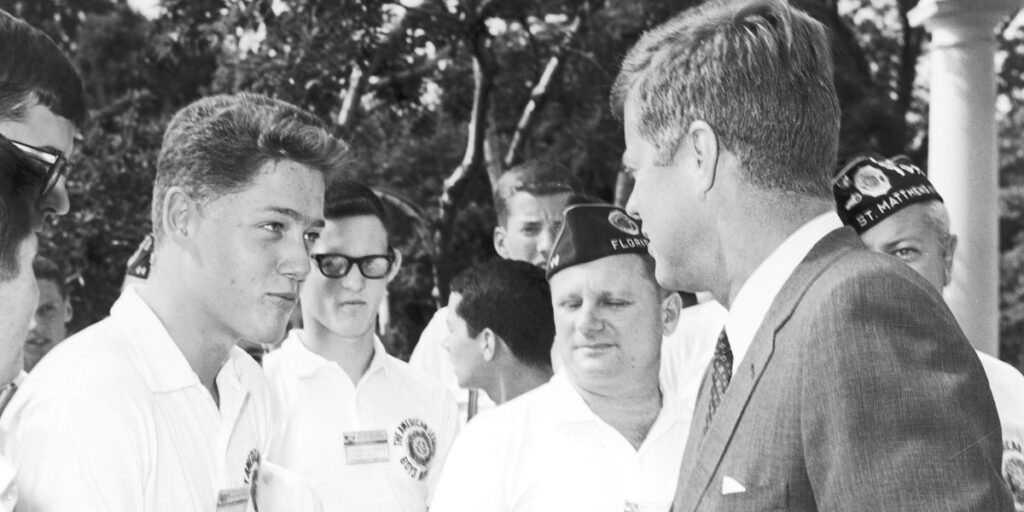
Just 16 years old, Bill Clinton was about to enter his senior year at Hot Springs High School. From a working-class family, Clinton’s biological father had died three months before he was born, and he was raised by his mother and an alcoholic, abusive step-father. Clinton’s life was a world away from that of the wealthy, urbane president, but, like many Americans, he deeply admired President John F. Kennedy and his family.
Clinton was a talented student but was still vacillating over his future, debating possible careers in music, medicine, law, or even the ministry. He was selected as one of Arkansas’ two delegates to that year’s Boys Nation. Organized by the American Legion and begun in 1946, the prestigious program brings some of the country’s best and brightest students to Washington, D.C. for an intensive, week-long seminar, where students meet with elected officials and government leaders. In 1963, that included Secretary of State Dean Rusk.
The 98 students held a series of mock-Senate legislative sessions, meant to provide the students with insight into the workings of the American government. As with the U.S. Congress, each student was able to sponsor legislation to be voted on by the body. Clinton’s proposals, including the creation of a Department of Housing and Urban Development and federal funding of campaigns, were unsuccessful (the U.S. Congress did pass an act creating the department known as HUD in 1965).
They met against the backdrop of a key moment in the Civil Rights Movement
That spring, America had become riveted by the civil rights campaign led by Rev. Martin Luther King Jr. and others in Birmingham, Alabama. The police had viciously suppressed the non-violent protests, unleashing fire hoses, dogs and batons on groups that included students as young as eight, part of a controversial Children’s Crusade.
On June 11, President Kennedy delivered a prime-time address to the nation, calling on Congress to pass civil rights legislation meant to end racial discrimination in public places and schools and expand voting rights for African Americans. The following day, NAACP field organizer Medgar Evers was assassinated at his Mississippi home, by white nationalist and KKK member Byron De La Beckwith.
Six weeks later, the students of Boys Nation passed a resolution against racial discrimination, and Clinton, who attended a then-segregated, all-white school but was a progressive Democrat, was one of the few Southern delegates who voted in favor. A month after Boys Nation, King and other leaders also met in Washington for the legendary March calling for jobs and economic freedom. Clinton later stated that two of the most influential events in his early life occurred that summer, including King’s “I Have a Dream” speech.
The highlight of the Boys Nation program was their meeting with President Kennedy
On July 24, Clinton and his fellow delegates gathered in the White House Rose Garden. Kennedy was fresh off a successful European tour that included his famous “Ich bin ein Berliner” speech in front of a crowd of 450,000 in West Berlin. He addressed a much smaller crowd that sunny summer day, speaking of the importance of public service. He also praised the students for their civil rights resolution, noting that earlier that week the annual meeting of the National Governors Association had been unable to pass a similar resolution, and remained divided over the issue.
Kennedy then moved into the crowd to meet the students. Clinton later recalled the moment, saying, “I was about the third or fourth person in, and…I sort of muscled my way up (to the front).” Their interaction was brief, a firm handshake before Kennedy moved on to the next student. But video and photos capturing the event show Clinton’s admiration and near disbelief that he was meeting one of his political idols.
The impact of that moment was obvious almost immediately. According to several of his fellow delegates, Clinton spent the bus ride back to the Boys Nation dorms talking about the event. As future Minnesota Congressman Jim Ramstad recalled, Clinton said to him, “Someday, I’m going to have that job.”
The Kennedy-Clinton meeting became a key part of Clinton’s political biography
Just four months later, Kennedy was dead. Clinton was in high school math class when he learned that Kennedy had been assassinated in Dallas, Texas on November 22, 1963. “I remember it as if it were yesterday,” Clinton said. “I was heartbroken. I was hoping he would live. We didn’t know in the beginning whether he was dead. I just remember being totally bereft.” Of the impact of that moment, he wrote, “He meant something to the country, and he symbolized the future. It was as if it was snuffed out.”
As Clinton’s political star began to rise, that fateful 1963 meeting loomed large as a turning point in his life. The photograph of the young, impressionable teen and the soon-to-be-slain president appeared in campaign ads and news accounts of Clinton’s formative years. While Clinton’s critics saw it as political opportunism, for others it was living proof of the lasting legacy of Kennedy’s “Ask not what your country can do for you; ask what you can do for your country” call to public service during his inaugural address.
In July 1993, 30 years later and following his election as the nation’s 42nd president, the 1993 Boys Nation class gathered in the White House Rose Garden. Vice President Al Gore jokingly noted that these future leaders might get a later political boost from their own photo with the president. Also present were several alumni of the 1963 Boys Nation class, who listened on as Clinton recalled the lasting impact of his meeting with Kennedy. As Clinton waded into the crowd just as his idol once had, the students presented him with a gift — an enlarged, framed copy of Bill and Jack, shaking hands.
